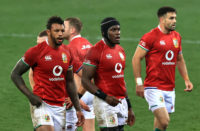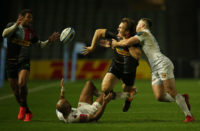 There is a body of opinion that the role of the openside flanker has changed significantly in the 41 years since The 1971 Lions Tour, but, while their main focus is no longer mugging fly-halves, the best No.7s are still hugely influential tactically and appear to have the same piratical skills and ferocity they always did.
There is a body of opinion that the role of the openside flanker has changed significantly in the 41 years since The 1971 Lions Tour, but, while their main focus is no longer mugging fly-halves, the best No.7s are still hugely influential tactically and appear to have the same piratical skills and ferocity they always did.
The Rugby Paper's chief writer, Nick Cain, says: “In terms of being key ball winners, tacklers, and support runners very little has altered, and, although there is a trend towards putting taller men in the openside shirt, the world's best practitioners are usually the shortest forwards in the back five of the pack.
“Openside remains the reserve of fast, fearless foragers whose job is also to slow down opposition ball at the breakdown or steal it and initiate counter- attacks. This makes them kings of the breakdown, and therefore right at the heart of the battle for tactical supremacy.
“In 1971 John Taylor emerged as a formidable Test openside, and the bushy-haired Welshman stayed there for the entire series over the All Blacks after his main rival, Fergus Slattery, was deprived of a start in the Third Test due to sickness. Taylor was an all-round footballer who was accomplished ball-in-hand and brought tenacity and mobility in the loose – he was also versatile enough to goal-kick for Wales – and he played a significant role in The Lions beating New Zealand for the only time.
“Slattery got his chance to shine on the 1974 Tour and took it in spectacular style. The Irish raider become an ever-present in the triumphant Test side, where his tackling and dynamic support play made him a scourge of the Springboks.
“Finlay Calder was the next Lions openside to get on the winners rostrum when the Scot captained The 1989 Lions to a 2-1 series win over a strong Australian outfit. The athletic, raw-boned Calder was a flinty character, and he led an uncompromising pack to wrench the final two Tests off the Wallabies.
“The Test openside on the two Tours to New Zealand, in 1983 and 1993, was Peter Winterbottom. Both series ended in defeat, but Winterbottom stood out, playing seven Lions Tests. The English tearaway was rugged, aggressive and fast, and the Kiwis were so impressed by him in the outclassed 1983 team that he was voted one of their five players of the year – and a decade later, having honed his handling skills, he was still good enough to claim the Test No.7 shirt.
“In 1997 two Englishmen, Richard Hill and Neil Back, tussled for The Lions openside shirt in the series victory over South Africa. Hill started the first two Tests, with the perpetual-motion Back coming off the bench for the last 24 minutes of the series-clinching Second Test win in Durban, and playing in the Third Test loss. The multi-talented Hill was outstanding in his four Tests for The Lions, and for the first one and a half Tests of the 2001 series against Australia he was so effective in cleaning out George Smith, the famed Wallaby ‘fetcher', that it put the tourists within sight of a second successive series win. However, when Hill was forced off with concussion after being struck by the elbow of Wallaby centre Nathan Grey in the Second Test, the game – and the series – slipped away.”
John Taylor himself says: “One of my favourites was Fergus Slattery. He was very quick, fearless and had terrific hands which provided a great link. I still think the No.7 has to be the link between the forwards and the backs. Martyn Williams was very good too and he was a very clever player.”
Also mentioned: John Taylor, Finlay Calder, Peter Winterbottom, Richard Hill, Neil Back and Martyn Williams.
Have your say: Tweet us @therugbypaper

























